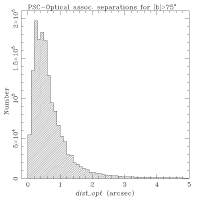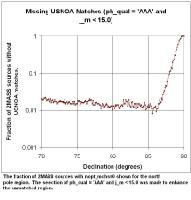IV. 2MASS Data Processing
4. Point Source Detection and Photometry
f. Optical Source Associations
The 2MASS position reconstruction algorithms
(cf. IV.6)
required positionally correlating infrared detections with objects
in the primary astrometric reference catalog,
Tycho 2.
Infrared sources were also correlated with the higher density
USNO-A2.0 catalog to monitor camera distortion.
2MASS PSC sources that have optical catalog counterparts
within approximately 5´´ of the PSC position have listed for
convenience the optical catalog identifier
(a="T" (Tycho) or "U" (USNOA)),
blue and visual-or-red magnitudes
(b_m_opt and
vr_m_opt),
the 2MASS/optical position separation
(dist_opt) and
position angle (phi_opt)
information listed in the PSC source record, for convenience.
It is stressed that optical data listed for the
PSC sources are derived from positional associations, and
not necessarily identifications.
Chance alignment of infrared and optical sources is possible,
especially in high source density regions.
The association reported is the closest optical source to the
2MASS source position, within a maximum
separation of approximately 5´´,
with a match to a Tycho 2 source taking precedence over
a USNO-A2.0 match. No association data is listed
if there is no Tycho 2 or USNO-A2.0 source within the association radius.
No attempt is made to find the best pairings of 2MASS and optical sources,
and an optical source can be matched to more than one
2MASS source. A measure of possible confusion in the
association process is given by the nopt_mchs parameter
in the PSC, which specifies the number of possible optical matches for each
2MASS point source within the ~5´´ search radius.
The relative accuracy of the PSC and the optical comparison catalogs
are sufficiently high, though, that separations larger than ~2´´
are good indications of chance associations, high proper motion,
or confusion. Figure 1 shows
the distribution of dist_opt values for the
1,608,024 PSC sources at |b|>75o that have
optical associations (84.4% of all high latitude sources);
>95% have dist_opt <2´´.
For Tycho 2 associations (a="T"), dist_opt
was computed using the mean Tycho 2 position (mRAdeg, mDEdeg),
corrected for proper motion to the time of the 2MASS observation
if proper motions were available. For Tycho 2 associations that do not
have mean positions, or for which the Tycho 2 posflg
was "D" (double star treatment) or "P" (photo-centre treatment),
the separation was computed using the observed Tycho 2
catalog position (RAdeg, DEdeg).
For USNO-A2.0 matches
(a="U"), dist_opt gives the simple separation between
PSC and USNO-A2.0 reported positions.
Because USNO-A2.0 was derived from plate material taken at a much
earlier epoch than 2MASS, proper motions can lead to larger separations
and possibly missed associations. Conversely, the large epoch difference
between USNO-A2.0 and 2MASS makes possible statistical studies
utilizing systematic motions of large samples of objects
(e.g., Adams et al.
2001 AJ, 121, 2053).
A software error in setting the PSC optical catalog identifier,
a, resulted in an incorrect
value of a="0" being assigned to optical associations that have
dist_opt 5´´.
There are 361,663 sources in the full PSC with this error. These objects
can be identified as having a="0" and non-null values in the
other optical association fields:
dist_opt,
phi_opt,
b_m_opt, and
vr_m_opt.
When searching for PSC sources with our without
optical associations, the value of the optical catalog identifier,
a, cannot be used alone as a discriminant.
5´´.
There are 361,663 sources in the full PSC with this error. These objects
can be identified as having a="0" and non-null values in the
other optical association fields:
dist_opt,
phi_opt,
b_m_opt, and
vr_m_opt.
When searching for PSC sources with our without
optical associations, the value of the optical catalog identifier,
a, cannot be used alone as a discriminant.
The optical magnitudes listed for the optical associations
in the PSC are derived from the Tycho 2 and USNO-A2.0 values.
In the case of Tycho 2 associations, the optical magnitudes listed
are Johnson B and V magnitudes and are derived
from the Tycho blue (BT) and visual (VT)
magnitudes using the transformations given by
(Høg et al. 2000, "Guide to the Tycho-2 Catalog"):
V = VT - 0.090 * (BT - VT)
B-V = 0.850 * (BT - VT)
For USNO-A2.0 associations, the optical magnitudes are
the photographic blue and red magnitudes taken explicitly from
the USNO-A2.0 Catalog.
Missed Optical Associations Near the Equatorial Poles
An error in the positional correlation procedure between 2MASS and
USNO-A2.0 sources resulted in associations being systematically
missed in the vicinity of the north and south equatorial poles.
In Figure 2 is shown the
fraction of bright, three-band 2MASS PSC sources without
optical counterparts
(nopt_mchs=0) plotted
as a function of declination within 20° of the north equatorial pole.
The fraction of PSC sources without reported counterparts
increases rapidly and monotonically with proximity to the pole for
declinations > 86°. Optical associations for PSC
sources near the south equatorial pole exhibit identical behavior.
An independent correlation between 2MASS and USNO-A2.0 sources in the
vicinity of the poles shows that most PSC sources do have
USNO-A2.0 counterparts within 5´´. Furthermore,
good agreement between 2MASS and USNO-A2.0 positions near the poles, and
the analysis of 2MASS astrometric accuracy
(e.g., VI.6.a.ii) indicate that there
is no evidence for systematic problem with 2MASS or USNO-A2.0 positions
near the poles. Therefore, the
apparent increase in fraction of sources without optical
counterparts shown in Figure 2 is an
artifact of the correlation processing.
For sources with |dec|>86°, the
optical association information is not reliable. The absence of optical
association data in the PSC record does not necessarily mean that there
is not an optical source within 5´´
of the 2MASS position.
 |
 |
| Figure 1 |
Figure 2 |
[Last Updated: 2003 July 1, by R. Cutri and H.McCallon]
Previous page. Next page.
Return to Explanatory Supplement TOC Page.
 5´´.
There are 361,663 sources in the full PSC with this error. These objects
can be identified as having a="0" and non-null values in the
other optical association fields:
dist_opt,
phi_opt,
b_m_opt, and
vr_m_opt.
When searching for PSC sources with our without
optical associations, the value of the optical catalog identifier,
a, cannot be used alone as a discriminant.
5´´.
There are 361,663 sources in the full PSC with this error. These objects
can be identified as having a="0" and non-null values in the
other optical association fields:
dist_opt,
phi_opt,
b_m_opt, and
vr_m_opt.
When searching for PSC sources with our without
optical associations, the value of the optical catalog identifier,
a, cannot be used alone as a discriminant.

